|
SAFE AND UNSAFE GARDENING

GARDEN TIPS
|
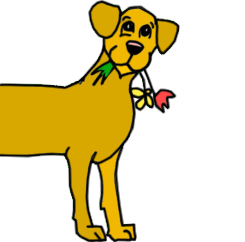
(original graphic by marvistavet.com)
|
Gardening is a relaxing pastime enjoyed by many people and many people allow pets in their garden. The garden shops and catalogs are full of gorgeous garden shrubs and flowers. They tell us how to water and how much sunshine is needed, but rarely do they tell us if the plant is safe in case your pet chews it up.
Your dog or cat is probably having visions of digging through or chewing up the plants. We’ll leave the fencing and reprimanding up to you, but just to be on the safe side, how about planting only non-toxic plants? If unplanned periodic demolition of the garden by the family dog (or even the cat) is a fact of life, it is good to know the plants he or she is chewing up are non-toxic. It may not help the garden any, but knowing your pet isn’t going to get sick because of it is one less thing to worry about. It’s good to know what is considered safe should the family pet get frisky and start chewing and digging in the flower beds. We’ll try to help out.
|
In the past we listed plants as “safe” or “toxic.” This seems straight-forward but turns out that there is more to it so let us be more specific.
|
Safe Plants: Can be chewed up or eaten with no ill effects of any kind.
Toxic Plants: Will not actually be dangerous to your pet but will give your pet a very unpleasant upset stomach or oral chemical irritation if he or she eats or chews them. The resulting discomfort may require medical treatment in order to feel better.
Poisonous Plants: Can potentially kill your pet or cause serious damage to their body if your pet eats or chews them.
|
|
Now there are hundreds if not thousands of flowers and shrubs available for gardening so we cannot go through them all but we CAN include some classics.
The following garden plants should cause no trouble of any kind.
|

Alyssum
(original graphic by marvistavet.com)
|

Gerber Daisy
(public domain image
via Wikimedia Commons)
|

Polkadot Plant (aka Baby Tears)
(original graphic by marvistavet.com)
|
|
|
|
|
|

Blue Daisy
(Photocredit: Morguefile.com)
|

Bottlebrush tree
(Photocredit: Morguefile.com)
|

Camellia
(original graphic by marvistavet.com)
|
|
|
|
|
|

Canna
(Photocredit: Morguefile.com)
|

Viola
(original graphic by marvistavet.com)
|

Christmas Cactus
(public domain image
via Wikimedia Commons)
|
|
|
|
|
|

Snap Dragon
(original graphic
by marvistavet.com)
|

Coreopsis
(Photocredit: Morguefile.com)
|
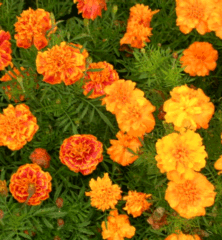
Marigold
(Photocredit: Morguefile.com)
|
|
|
|
|
|

Gloxinia
(Photocredit: Scott Zona via Wikimedia Commons)
|

Star Jasmine
(original graphic
by marvistavet.com)
|

Nasturtium
(original graphic by marvistavet.com)
|
|
|
|
|
|

Pampas Grass
(Photocedit: Eurico Zimbres via Wikimedia Commons)
|

Impatiens
(Photocredit: Morguefile.com)
|

Petunia
(original graphic by marvistavet.com)
|
|
|
|
|
|

Rose
(Photocredit: Morguefile.com)
|

Sword Fern
(Photocredit: JenahsysJayde via Wikimedia Commons)
|
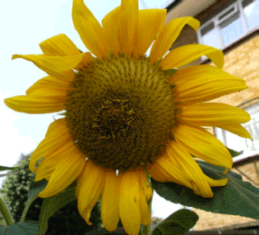
Sunflower
(Photocredit: Morguefile.com)
|
|
|
|
|
|

Zinnia
(Photocredit: Morguefile.com)
|

Spider Plant
(Photocredit: Morguefile.com)
|

Persian Violet
(Photocredit: Mokkie via Wikimedia Commons)
|
|
|
|
|
|

Boston Fern
(original graphic by marvistavet.com)
|

Echevaria succulents
(original graphic by marvistavet.com)
|
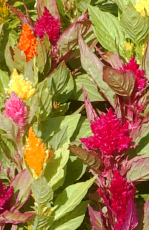
Celosia plumosa
(original graphic by marvistavet.com)
|
|
Catnip was brought to America by early colonists and was considered to be a commercial crop. Numerous medicinal properties have been ascribed to catnip and it has been used in teas, soaks, and poultices. Today its uses are largely confined to feline entertainment as its active ingredient, cis-trans-nepetalactone, is a mild hallucinogen. Rubbing, rolling, and other merry-making actions are produced, though one should be careful as aggressive behavior is often made worse by catnip indulgence.
Response to catnip is inherited genetically as a dominant trait which means that not all cats will be affected. Further, kittens under age 6-8 weeks are not able to respond.
Catnip is felt to be a safe and non-addictive recreational drug for cats but there is some thinking that overdose can produce seizures. For this reason, it is best not used in cats with a history of seizures. Chronic exposure to catnip may cause an apparent loss of mental faculty and possibly personality change. Also, it is not a good idea to put catnip in a carrier or box for transportation as by the time the cat arrives, some unpleasant mental changes may be in progress making the cat more aggressive and more stressed than he/she would be had no hallucinogens been involved.
|

Catnip plant (Nepeta cataria)
(Photocredit: Morguefile.com)
|
Catnip can be a fun garden plant if the climate is right but can quickly turn into a weed problem if one is not careful. Catnip should be considered an occasional treat for cats able to respond to it.
The plants listed below are listed sometimes as “non-toxic” because they won’t hurt you in the big picture. They are also listed in other sources as “toxic” because you will be very sorry if you attempt to eat them. Some will release burning crystals into your mouth; others just induce vomiting and diarrhea. Think twice before planting them where the family pet might find them tempting.
|

Mother-in-law’s tongue
(oxalate crystals in the plant embed in the
mouth causing pain and inflammation)
(Photocredit: Public Domain Graphic via Wikimedia Commons)
|

Calla lily
(oxalate crystals in the plant embed in the
mouth causing pain and inflammation)
(Photocredit: Morguefile.com)
|

Dumb Cane
(oxalate crystals in the plant embed in the
mouth causing pain and inflammation)
(Photocredit: Mokkie via Wikimedia Commons)
|
|
|
|
|
|

Pansy (causes gastrointestinal upset)
(Photocredit: Morguefile.com)
|

Kalanchoe (causes gastrointestinal upset
and rarely heart rhythm disturbance)
(Photocredit: Morguefile.com)
|
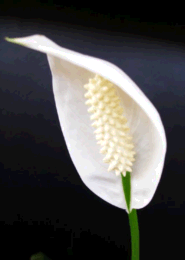
Peace Lily (oxalate crystals in the plant
embed in the mouth causing pain and inflammation)
(Photocredit: Morguefile.com)
|
|
|
|
|
|

Geranium
(causes upset stomach)
(original graphic by marvistavet.com)
|
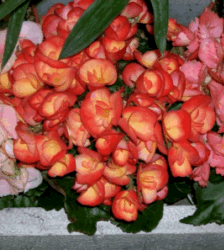
Begonia
(oxalate crystals in the plant embed in
the mouth causing pain and inflammation)
(Photocredit: KENPEI via Wikimedia Commons)
|

Bird of Paradise
(upset stomach and drowsiness)
(original graphic by marvistavet.com)
|
|
|
|
|
|

Aloe
(causes upset stomach,
can also cause tremors)
(Photocredit: Morguefile.com)
|

Carnation
(causes upset stomach)
(Photocredit: Morguefile.com)
|
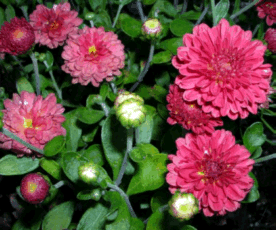
Chrysanthemum
(causes upset stomach, drooling, incoordination)
(Photocredit: Morguefile.com)
|
|
|
|
|
|

Elephant Ear
(causes intense burning of the mouth, vomiting)
(Photocredit: Morguefile.com)
|

Fleabane
(causes upset stomach)
(original graphic by marvistavet.com)
|

Gardenia
(causes upset stomach and hives)
(Photocredit: Morguefile.com)
|
|
|
|
|
|

Hibiscus (causes upset
stomach & appetite loss)
(Photocredit: Morguefile.com)
|

Hydrangea
(causes upset stomach)
(Photocredit: Morguefile.com)
|

Iris (causes
upset stomach.
Bulb is most toxic)
(Photocredit: Morguefile.com)
|
|
|
|
|
|

Pinks (Dianthus) (Causes
upset stomach and dermatitis)
(Photocredit: Morguefile.com)
|

Primrose
(causes mild upset stomach)
(Photocredit: Morguefile.com)
|
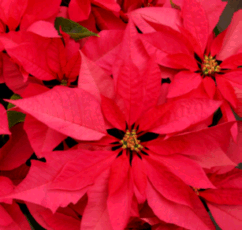
Poinsettia (causes mouth
irritation and upset stomach)
(Photocredit: Morguefile.com)
|
|
|
|
|
|

Coleus
(causes vomiting/diarrhea
either of which can be bloody)
(Photocredit: Morguefile.com)
|

Bougainvillea
(can cause gastrointestinal upset)
(original graphic by marvistavet.com)
|
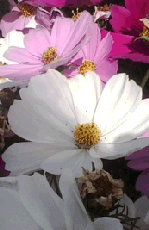
Cosmos (can cause gastrointestinal upset)
(original graphic by marvistavet.com)
|
|
|
|
|
|
|

Plumbago
(causes contact dermatitis and makes
skin more sensitive to sun exposure)
(Photocredit: J.M. Garg via Wikimedia Commons)
|
|
PLANTS THAT CAN KILL YOUR PET
The following plants are poisonous and can cause death depending on the quantity ingested. It is probably best not to take any chances with these and keep them away from pets, children or anyone else you care about who might not have good sense about chewing on plants.
|

Cyclamen
(causes heart arrhythmias if the root/tuber is eaten in large quantities, otherwise just upset stomach)
(Photocredit: Morguefile.com)
|

Azalea
(Contains “grayanotoxin” which causes cardiovascular collapse)
(Photocredit: Morguefile.com)
|

Easter Lily
(Causes kidney failure in cats)
(Photocredit: Morguefile.com)
|
|
|
|
|
|

Sago Palm
(Causes liver failure and interferes with blood clotting)
(Public Domain Image /via Wikimedia Commons)
|
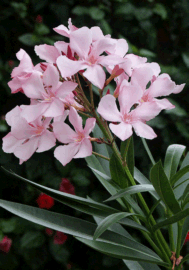
Oleander
(Poisons the heart)
(Photocredit: Ian Fieggen via Wikimedia Commons)
|

Foxglove
(Poisons the heart)
(Photocredit: Morguefile.com)
|
|
|
|
|
|
|
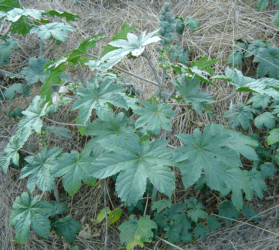
Castor Bean
(Causes convulsions, kidney failure, and rapid death).
(Photocredit: Undead_Warrior via Wikimedia Commons)

The beans are commonly
made into necklaces which are
also extremely lethal if chewed up
(Photocredit: H. Zell via Wikimedia Commons)
|
|
|
|
|
|
|

Tiger Lily
(Other Day Lilies such as those shown above also cause kidney failure in cats.)
(Photocredits: Morguefile.com)
|
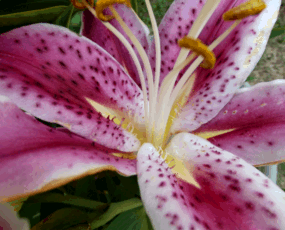
Star Gazer Lily
(Other Day Lilies such as those shown above also cause kidney failure in cats.)
(Photocredits: Morguefile.com)
|

Daffodil
(especially the bulb)
(Causes convulsions, tremors and heart arrhythmia)
(Photocredit: Morguefile.com)
|
Want more information or wondering about a plant we didn’t list? National Animal Poison Control has a searchable database with photographs at:
www.aspca.org/pet-care/animal-poison-control/toxic-and-non-toxic-plants
We also recommend keeping the phone number for National Animal Poison Control handy in case of emergency: 1-888-426-4435
This external link was put together by Rover and Pet Poison Helpline to review common household and garden plants which might be toxic to our pets. Common and scientific names of plants are listed and graphics are included. An excellent site for any pet owner to review.
https://www.rover.com/blog/poisonous-plants
Designing a Dog Friendly Garden:
www.gardeningknowhow.com/special/spaces/creating-a-dog-friendly-garden.htm

Page last updated: 8/13/2020
Page last reviewed: 7/20/2022
|